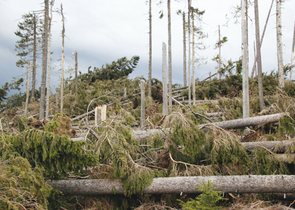Nature Conservation 1/2008 — 26. 2. 2008 — On Nature in the Czech Republic
Hurricane Kyrill and Natura 2000 Sites in the Šumava/Bohemian Forest National Park
v Národním parku Šumava

Těsně před vstupem České republiky do EU v roce 2004, kdy finišovaly práce na mapování a vyhodnocení výskytu evropsky významných biotopů, si jen málokdo plně uvědomoval, že se Česká republika jako nový členský stát zavazuje respektovat evropská pravidla ochrany přírody.
Within the Šumava/Bohemian Forest National Park, a proposed Site of Community Interest (pSCI), covering almost 172,000 hectares was delimitated, as well as a Special Protection Area (SPA) which are inha-bited by a lot of wild plant and animal species protected by the European Community's Habitats Directive, Birds Directive respectively. Both areas are a part of the European Community's Natura 2000 network. The wildlife species living there and protected under the European Community's legislation include i.e the Eurasian Lynx (Lynx lynx), Bullhead (Cottus gobio), Eurasian Otter (Lutra lutra), Large Mouse-eared Bat (Myotis myotis), Lesser Horseshoe Bat (Rhinolophus hipposideros), Freshwater Pearl Mussel (Margaritifera margaritifera), Brook Lamprey (Lampetra planeri), Bohemian Menetries Ground Beetle (Carabus menetriesi pacholei), Bohemian Gentian (Gentianella praecox subsp. bohemica), from birds the Capercaillie (Tetrao urogallus), Black Grouse (Tetrao tetrix), Hazel Grouse (Tetrastes bonasia), Corncrake (Crex crex), Black Stork (Ciconia nigra), Black Woodpecker (Dryocopus martius), Three-toed Woodpecker (Picoides tridactylus), Tengmalm's Owl (Aegolius funereus) and the Pygmy Owl (Glaucidium passerinum). After the hurricane Kyrill which had hit forests in the Šumava/Bohemian Forest and Bayerische Wald/Bavarian Forest National Parks in January 2007, the staff members of the Šumava/Bohemian Forest National Park Administration proposed how to deal with affects of the natural disaster. The proposal was reviewed by the experts in assessing external factors influencing the Natura 2000 sites. Within the assessment, management measures were recommended for the particular parts of the National Park as well as for the individual natural habitat types aiming at removing the hurricane Kyrill affects. The areas which shoauld be left to natural succession process to maintain forest ecosystem integrity were also identified. For the areas where wind damages should be treated, the conditions mitigating affects of the above sudden and huge change in the forest ecosystems were set. At the sites important from an ecological point of view, appropriate technologies for treating the wind damages, the proportion of the raw wood left there and further measures keeping bark boring insects out of spreading and outbreaks were agreed. Implementing all management measures has been coordinated with colleagues from the Bayerische Wald/Bavarian Forest National Park Administration.

